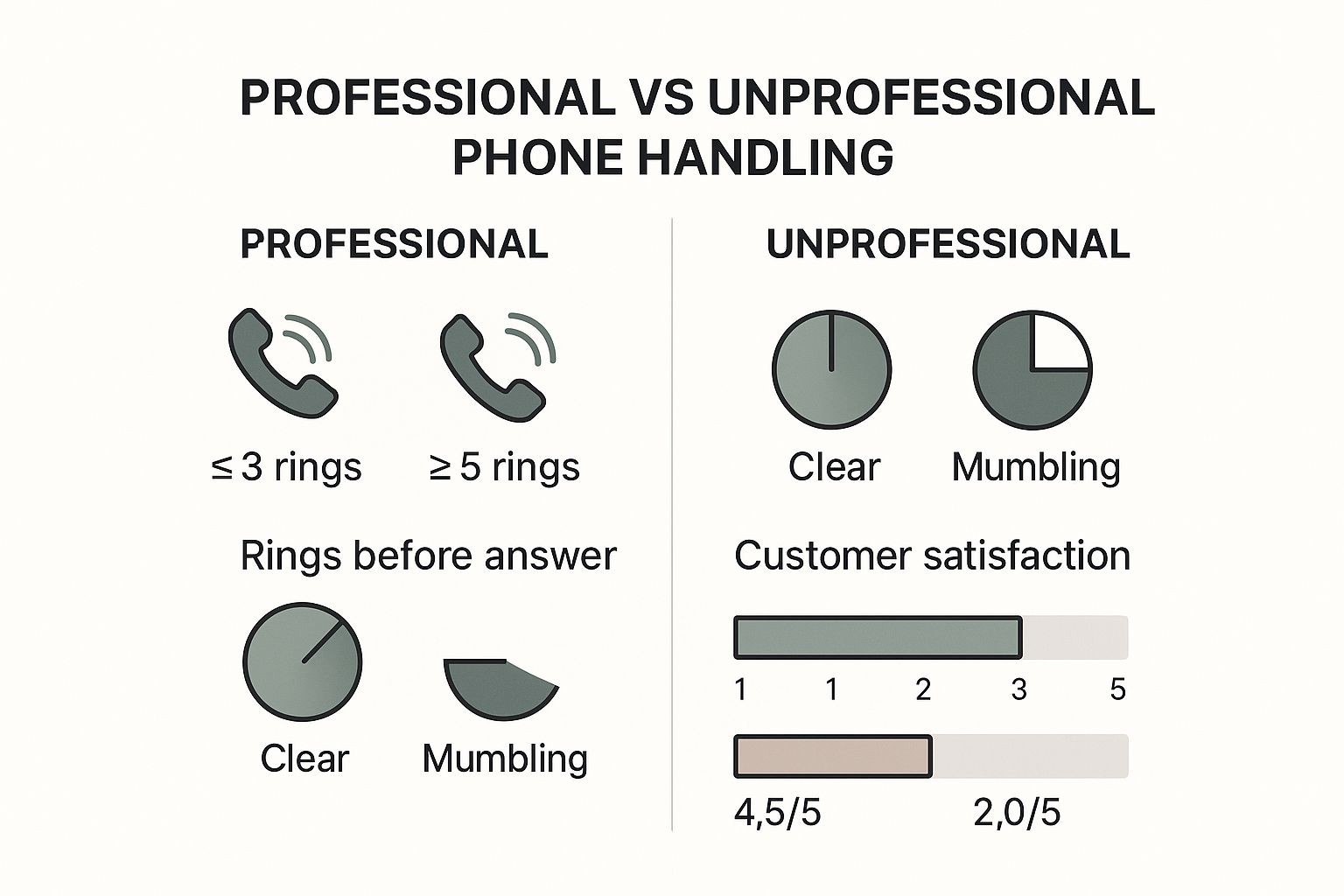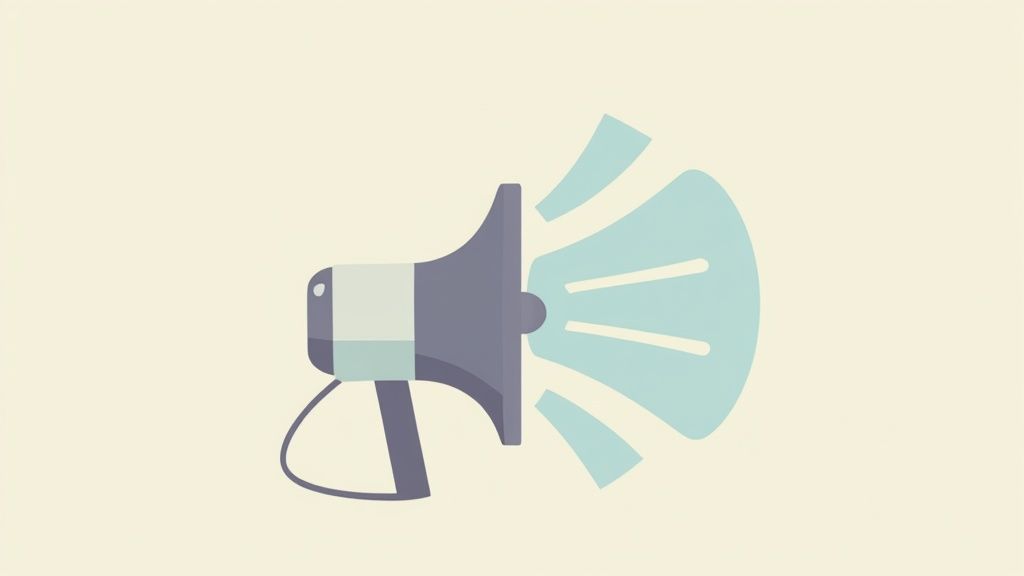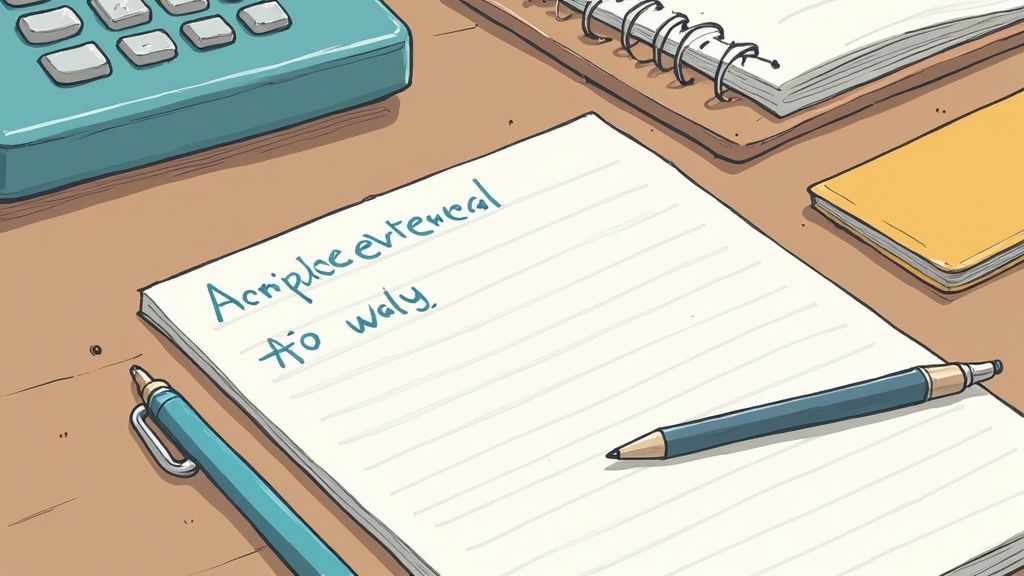Knowing how to answer the phone professionally really just boils down to a simple, effective formula: greet the caller, state your company's name, and introduce yourself. This immediate clarity sets a competent tone right from the start and lets the caller know they've reached the right place without any confusion.
Crafting the Perfect Professional Phone Greeting
The first five seconds of a call are incredibly powerful; they establish the entire mood of the conversation. I've seen it time and time again—a well-executed greeting does more than just answer the phone. It conveys warmth, competence, and a readiness to help, making the caller feel instantly valued. Moving beyond stiff, generic scripts is the secret to sounding authentic.
This is especially vital because, despite all our digital tools, the phone is still a go-to for many customers. Inbound calls remain the most popular channel (53.1%) for seeking support. What’s more, a huge majority of customers, from 71% of Gen Z to 94% of baby boomers, still prefer live phone communication over digital options.
Greeting Formulas for Any Situation
The best greeting isn't one-size-fits-all. A busy receptionist needs a different approach than a manager answering a direct line. The goal is always to be both clear and efficient.
The most effective greetings are concise yet comprehensive. A caller should know exactly who they've reached and how you can assist them, all within a few seconds of you picking up the phone.
The infographic below really drives home the difference in customer perception between professional and unprofessional call handling.

As you can see, simple actions like answering promptly and speaking clearly can dramatically boost customer satisfaction scores. For a deeper dive into specific scripts and expert tips, be sure to check out our complete guide on how to answer the phone professionally.
Finding Your Perfect Greeting
To create a greeting that feels natural and fits your specific role, it helps to start with a solid structure. These adaptable formulas provide a professional framework that you can tweak to sound like yourself.
Here are a few common greeting structures that work well in different professional scenarios:
Professional Phone Greeting Formulas
| Scenario | Greeting Formula | Example |
|---|---|---|
| General Reception | Good [Time of Day], [Company Name], this is [Your Name]. How can I help you? | "Good morning, Marlie AI, this is Alex. How can I help you?" |
| Direct Line | [Your Name] speaking. | "Alex speaking." |
| Specific Department | Thank you for calling [Department] at [Company Name]. You're speaking with [Your Name]. | "Thank you for calling the Service Department at Marlie AI. You're speaking with Alex." |
Think of these formulas as starting points. The key is to deliver them with a friendly, confident tone. With a little practice, these structures will help you sound polished and professional every time you pick up the phone.
Your Tone Can Make or Break a Call

It’s one thing to know what to say on a business call, but it’s another thing entirely to know how to say it. Your vocal tone is a massively underrated tool. It can instantly communicate confidence and competence—or it can make you sound hesitant and disinterested, shaping the caller's entire perception of your business before you've even gotten to the point.
This is a bigger deal than you might think. A surprising number of people just aren't comfortable on the phone. In fact, some workplace communication studies show that only 39.7% of workers actually feel confident answering business calls. That lack of confidence bleeds directly into their tone. You can dig into the numbers in the full workplace communication report on emailtooltester.com.
Projecting Confidence Through Your Voice
When you’re learning how to answer the phone professionally, getting your vocal delivery right is half the battle. One of the simplest tricks I’ve learned is to sit up straight or even stand up while you’re talking. It’s a small physical change that opens up your diaphragm and naturally injects more energy and clarity into your voice.
You also want to speak at a moderate, composed pace—not rushing through your sentences or dragging them out. And here’s another trick that sounds a bit silly but works wonders: smile before you pick up the phone. A genuine smile can actually be heard in your voice, making you sound far more positive and approachable from the very first hello.
Using Positive, Solution-Focused Language
The words you choose have the power to either pour fuel on a fire or put it out completely. Trading negative, dead-end phrases for positive, solution-oriented ones is a non-negotiable skill for anyone in a customer-facing role. It’s all about reframing the conversation to show the caller you’re their partner in solving this, not just another roadblock.
For instance, never just say, "I don't know." That’s a conversation killer. A much stronger approach is, "That's a great question. Let me find that out for you." See the difference? One is a dead end; the other opens a path forward.
Key Takeaway: Steer clear of definitive negatives like, "We can't do that." Always pivot to what you can do. Try something like, "While that particular option isn't available, here's what we can do instead…"
This shift in language isn't just about sounding nice; it demonstrates initiative and a genuine commitment to helping. For more real-world examples, you can check out our telephone etiquette sample scripts for a variety of common situations. Mastering this one skill will help you handle virtually any interaction with poise and professionalism.
Navigating Common Call Scenarios with Confidence

While no two calls are exactly alike, you'll start to notice patterns pretty quickly. A lot of conversations fall into a few common buckets.
Getting comfortable with these frequent scenarios—like transferring a call or taking a message—is what separates the pros from the novices. It’s about having a game plan so you’re not caught off guard. Let's get into the specifics of how to handle these situations with real confidence.
Handling Call Transfers Smoothly
Transferring a caller shouldn't feel like you're launching them into the void. The absolute key is to execute a "warm handoff" where you prepare both the caller and the person you're transferring them to. Blindly forwarding a call is a major customer service sin.
First, always tell the caller what you're doing and get their buy-in. Explain who can best help them and confirm they're okay with being transferred.
Something as simple as, "The person best equipped to help is Sarah in our billing department. Would you mind if I transfer you?" makes all the difference.
Next, give the recipient a quick heads-up. Before you complete the transfer, quickly message or tell your colleague, "I have John on the line about the invoice from last week." This tiny step allows them to greet the caller by name and with context, turning a cold, frustrating transfer into a genuinely helpful one.
A warm handoff shows you respect everyone’s time. You save the caller from the agony of repeating their story, which is a massive source of frustration. This small gesture instantly elevates the entire interaction.
Taking Messages That Actually Work
When someone isn't available, taking a message is more than just scribbling a name on a sticky note. A vague "Jim called" helps no one. Your goal is to capture a complete, accurate, and actionable message every single time.
Develop a consistent system for grabbing the essential details. Make sure you get:
- Who Called? The caller's full name and their company. Don't be afraid to ask, "Could you please spell that for me?" for any names that aren't crystal clear.
- Contact Information: A direct call-back number is a must. Grabbing their email address is a great backup.
- Reason for Calling: Get a clear, concise summary. A great prompt is, "So they have some context, what should I let them know this is regarding?"
- Urgency: Is there a deadline? Did they mention anything time-sensitive? Make a note of it.
Before you hang up, quickly repeat the key details back to the caller. This one step is huge for building trust. Try this: "Okay, I have that you're Mark from Apex Industries, and you'd like a call back at 555-1234 about the new project timeline. Is that all correct?"
This simple confirmation shows you were paying attention and ensures the message delivered is one your team can actually act on.
De-Escalating Calls from Difficult Customers
Sooner or later, you're going to get a call from someone who is seriously unhappy. It's a rite of passage, and how you handle it is a true test of your professionalism. The goal isn’t to win the argument—it's to lower the temperature and find a way forward.
The first, and maybe hardest, thing to do is just let them talk. Don't interrupt. Let them get it all out.
More often than not, they just need to feel heard. While they're talking, show you're actually listening. Small verbal nods like "I see," "Okay," or "I understand" go a long way. They signal you're engaged and taking their complaint seriously, not just waiting for your turn to speak.
Acknowledge Their Frustration and Apologize Sincerely
Once they’ve had their say, your next move is critical. You need to acknowledge what they're feeling and offer a genuine, sincere apology. This isn't about admitting your company is at fault; it's about apologizing for the bad experience they've had. A real apology can completely reset the tone of the call.
It can be a powerful moment of connection that shifts the entire dynamic.
Try saying something like, “I am so sorry you’ve had to deal with this. That sounds incredibly frustrating, and I want to help.” This simple phrase validates their feelings and immediately puts you on their side.
This kind of empathy builds a bridge from their anger toward a solution. It’s an incredibly effective way to defuse tension and start pivoting the conversation.
Guide the Conversation to a Productive Outcome
After you’ve apologized, it’s time to gently take the lead. Clearly explain the next steps you're going to take to help them. Always use positive, forward-looking language. Ditch trigger words like "but" or blaming phrases like "you should have," which will only put them back on the defensive.
Instead, frame it as a team effort. Try one of these:
- “Let's work together to figure this out.”
- “Here’s what I can do for you right now.”
- “To make sure I have all the details, could you quickly confirm…?”
By focusing on collaboration and immediate action, you turn a complaint into a problem-solving session. You’re not just fixing the issue at hand—you’re showing them you’re committed to making things right. This approach can often save what seems like a lost customer relationship.
How to End a Call and Follow Up Professionally

We've all been there: a fantastic conversation that ends with a clunky, awkward goodbye. How you end a business call is just as critical as how you start it. This is your last chance to make an impression, and it's what the caller will remember most.
Before you even think about saying goodbye, take a second to recap the highlights of the conversation. It’s a simple move, but it immediately shows you were paying attention and reassures both of you that you're on the same page.
Confirming Next Steps
Clarity is everything here. A vague "we’ll get back to you" is the enemy of a good customer experience. People hang up feeling uncertain and, frankly, a bit ignored.
Instead, give a concrete summary of what's going to happen next. This small detail can make a huge difference in how reliable your business appears.
Here are a couple of real-world examples:
- "Just to confirm, I'll email you that service quote within the hour."
- "Okay, so I have your message for Sarah, and I’ll make sure she gets it as soon as she's back."
This kind of proactive confirmation isn't just polite; it builds trust. It tells the caller you're on top of it.
The goal is to eliminate all ambiguity. A caller who hangs up feeling confident about the next steps is a caller who trusts your business.
Once everything is crystal clear, wrap it up with a warm, courteous closing. Something as simple as, "Thank you for calling today, have a great afternoon!" leaves things on a positive, professional note.
And one last pro tip: always let the caller hang up first. This subtle piece of phone etiquette ensures they never feel rushed off the line. It's the final polish on a perfect call.
For more hands-on advice for every stage of a customer interaction, check out our complete guide on call handling best practices.
Even when you've got the basics down, some real-world situations can feel a little tricky. Let's walk through some of the most common questions that pop up during the workday and how to handle them. After all, answering the phone professionally is as much about reacting in the moment as it is about following a script.
A big one I hear a lot is how to deal with a call from a completely unknown or blocked number. My advice? Just answer it with your standard professional greeting.
If it turns out to be a spam or sales call, you can politely but firmly shut it down. A simple, "Thank you, but we are not interested at this time," is all you need before hanging up. There's no need to be rude, but you also don't need to waste your time.
That direct human touch, even for just a few seconds, is surprisingly powerful. Most people can't stand automated systems.
A recent survey found that a whopping 85% of consumers will just hang up when they hit a frustrating auto attendant or IVR system. Even more telling, 51% might ditch a business entirely after just one bad automated experience.
Those numbers really drive home the value of having a real person pick up the phone. If you're curious, you can dig into more of these eye-opening business phone statistics on Phonely.ai and see just how much a human connection matters.
Handling Calls During Other Tasks
What happens when the phone rings right in the middle of an important task? We've all been there. The absolute key is to avoid sounding rushed or distracted.
If you have to answer, give the caller your complete attention for the few seconds it takes to greet them properly. If you genuinely can't give them the time they deserve, it's far better to offer a quick callback than to provide hurried, subpar service.
You could say something like:
- "I'm currently assisting another client, but I can call you back in 15 minutes. Would that work for you?"
- "You have my full attention. How can I help you?" (Only use this if you can truly pivot and focus on them.)
This approach shows respect for the caller's time while still letting you manage your own workload. It’s a win-win.
Finally, there’s a small but important difference between answering a shared company line versus your personal desk phone. For a shared line, always lead with the company name ("Thank you for calling Marlie AI…"). For your direct line, it's perfectly fine—and often better—to lead with your own name ("Alex speaking."). It just feels a bit more personal and direct.
Ready to ensure every call is answered with flawless professionalism, 24/7? Marlie Ai provides an instant, friendly, and intelligent response so you never miss an opportunity. Discover how our AI phone assistant can book jobs, capture details, and boost your business at https://www.marlie.ai.

